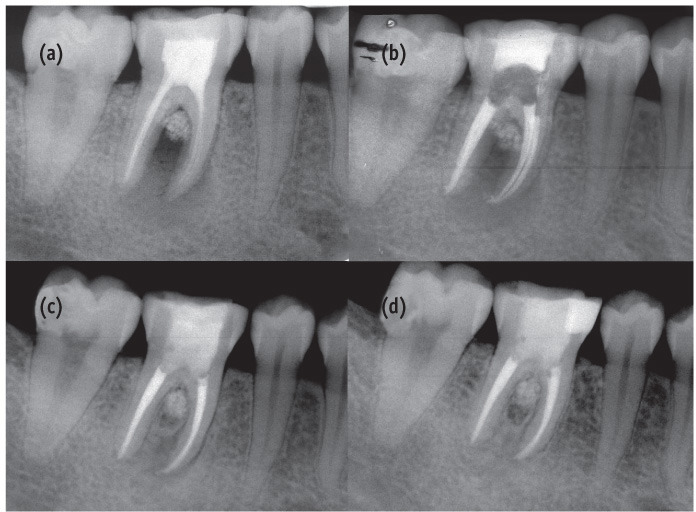Restor Dent Endod.
2014 May;39(2):115-119.
Management of failed periodontal surgical intervention for a furcal lesion with a nonsurgical endodontic approach
- Affiliations
-
- 1Iranian Center for Endodontic Research (ICER), Research Institute of Dental Sciences, Shahid Beheshti University of Medical Sciences, Tehran, Iran.
- 2Dental Research Center, Research Institute of Dental Sciences, Shahid Beheshti University of Medical Sciences, Tehran, Iran. dr.mfazlyab@gmail.com
Abstract
- As long as the prognosis of teeth remains a matter of concern, the endodontic-periodontal relationship will be considered a challenge for the clinician. Many etiologic factors, including bacteria, fungi, and viruses, plus other contributing factors, such as trauma, root resorptions/perforations, and dental malformations, play a role in the co-occurrence of endodontic and periodontal lesions. Whatever the cause, a correct diagnosis on which to base the treatment plan is the key to successful maintenance of the tooth. This article reports the successful endodontic management of a furcation lesion in a mandibular molar that was nonresponsive to a previous periodontal surgical graft. The case had presented a diagnostic challenge for the clinicians, and this article reviews the key points that can lead to a correct diagnosis and treatment planning.
Figure
Reference
-
1. Zuza EP, Toledo BE, Hetem S, Spolidório LC, Mendes AJ, Rosetti EP. Prevalence of different types of accessory canals in the furcation area of third molars. J Periodontol. 2006; 77:1755–1761.
Article2. Oved-Peleg E, Lin S. Periodontal-endodontal interactions. Refuat Hapeh Vehashinayim. 2005; 22:43–51. 913. Seltzer S, Bender IB, Ziontz M. The interrelationship of pulp and periodontal disease. Oral Surg Oral Med Oral Pathol. 1963; 16:1474–1490.
Article4. Zehnder M, Gold SI, Hasselgren G. Pathologic interactions in pulpal and periodontal tissues. J Clin Periodontol. 2002; 29:663–671.
Article5. Tanomaru JM, Leonardo MR, Tanomaru-Filho M, da Silva LA, Ito IY. Microbial distribution in the root canal system after periapical lesion induction using different methods. Braz Dent J. 2008; 19:124–129.
Article6. Uzun Ö, Topuz Ö, Aslan S, Tinaz AC. Effects of simulated lateral canals on the accuracy of measurements by an electronic apex locator. J Can Dent Assoc. 2012; 78:c65.7. De Deus QD. Frequency, location, and direction of the lateral, secondary, and accessory canals. J Endod. 1975; 1:361–366.
Article8. Jansson LE, Ehnevid H. The influence of endodontic infection on periodontal status in mandibular molars. J Periodontol. 1998; 69:1392–1396.
Article9. Lin S, Tillinger G, Zuckerman O. Endodontic-periodontic bifurcation lesions: a novel treatment option. J Contemp Dent Pract. 2008; 9:107–114.
Article10. Alkahtani A, Al-Subait S, Anil S. An in vitro comparative study of the adaptation and sealing ability of two carrier-based root canal obturators. ScientificWorldJournal. 2013; 2013:532023.11. Gillen BM, Looney SW, Gu LS, Loushine BA, Weller RN, Loushine RJ, Pashley DH, Tay FR. Impact of the quality of coronal restoration versus the quality of root canal fillings on success of root canal treatment: a systematic review and meta-analysis. J Endod. 2011; 37:895–902.
Article12. Ray HA, Trope M. Periapical status of endodontically treated teeth in relation to the technical quality of the root filling and the coronal restoration. Int Endod J. 1995; 28:12–18.
Article13. Saunders WP, Saunders EM. Assessment of leakage in the restored pulp chamber of endodontically treated multirooted teeth. Int Endod J. 1990; 23:28–33.
Article14. Rotstein I, Simon JH. Diagnosis, prognosis and decision-making in the treatment of combined periodontal-endodontic lesions. Periodontol 2000. 2004; 34:165–203.
Article15. Trope M, Bergenholtz G. Microbiological basis for endodontic treatment: can a maximal outcome be achieved in one visit? Endodontic Topics. 2002; 1:40–53.
Article16. Reit C, Molander A, Dahlén G. The diagnostic accuracy of microbiologic root canal sampling and the influence of antimicrobial dressings. Endod Dent Traumatol. 1999; 15:278–283.
Article17. Reit C, Dahlén G. Decision making analysis of endodontic treatment strategies in teeth with apical periodontitis. Int Endod J. 1988; 21:291–299.
Article18. Figini L, Lodi G, Gorni F, Gagliani M. Single versus multiple visits for endodontic treatment of permanent teeth. Cochrane Database Syst Rev. 2007; 4:CD005296.
Article19. Naito T. Single or multiple visits for endodontic treatment? Evid Based Dent. 2008; 9:24.
Article20. K B. Trial suggests no difference between single-visit and two-visit root canal treatment. Evid Based Dent. 2013; 14:48.
Article21. Paqué F, Balmer M, Attin T, Peters OA. Preparation of oval-shaped root canals in mandibular molars using nickel-titanium rotary instruments: a micro-computed tomography study. J Endod. 2010; 36:703–707.
Article22. Gulabivala K, Patel B, Evans G, Ng YL. Effects of mechanical and chemical procedures on root canal surfaces. Endodontic Topics. 2005; 10:103–122.
Article23. Siqueira JF Jr, Lima KC, Magalhães FA, Lopes HP, de Uzeda M. Mechanical reduction of the bacterial population in the root canal by three instrumentation techniques. J Endod. 1999; 25:332–335.
Article24. Coldero LG, McHugh S, MacKenzie D, Saunders WP. Reduction in intracanal bacteria during root canal preparation with and without apical enlargement. Int Endod J. 2002; 35:437–446.
Article
- Full Text Links
- Actions
-
Cited
- CITED
-
- Close
- Share
- Similar articles
-
- Endodontic treatment enhances the regenerative potential of teeth with advanced periodontal disease with secondary endodontic involvement
- Treatment of a lateral incisor anatomically complicated with palatogingival groove
- Guided tissue regeneration therapy after root canal therapy for long standing periodontal-endodontic combined lesion in the mandibular anterior area: case report
- Surgical management of a failed internal root resorption treatment: a histological and clinical report
- Prognostic factors influencing clinical outcome of nonsurgical endodontic treatment


